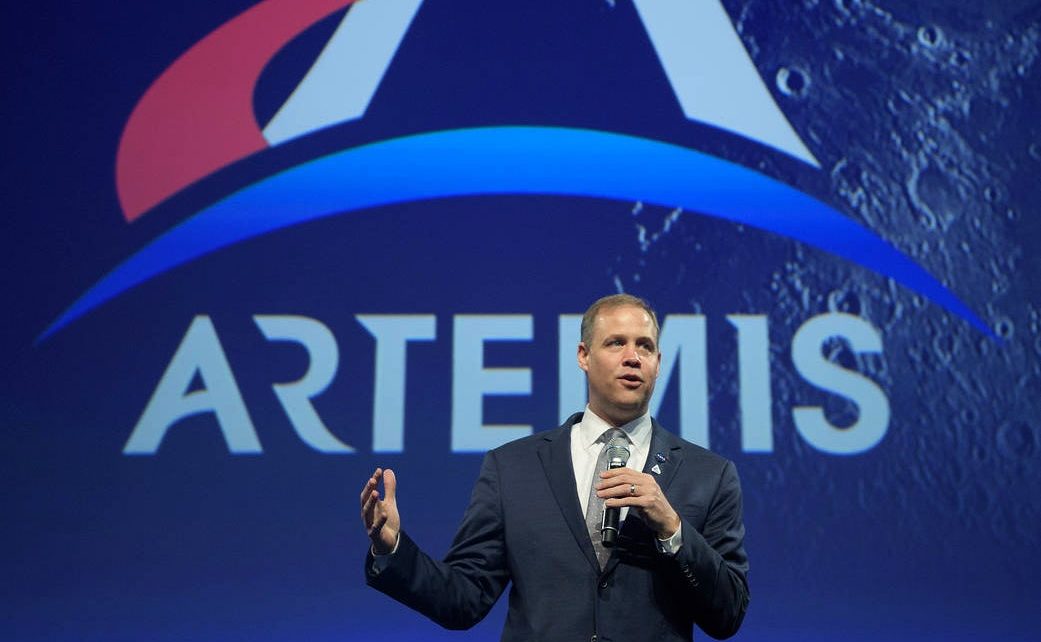If all goes according to plan, humans will be visiting—and developing—the moon and its resources well before the decade is out, following multiple nations ramping up their lunar-exploration efforts. But will this new frontier be a stage for competition or collaboration? NASA’s newly released set of ideals—called the Artemis Accords—aims to ensure international cooperation and a “safe, peaceful, and prosperous future” for everyone on the moon—provided they abide by the accords and partner with the U.S.
The accords stem from NASA’s Artemis program, catapulted into being by President Donald Trump’s White House and a National Space Council edict to return astronauts to the Moon by 2024. Artemis involves activities in cislunar space—that is, between the Earth and the moon—and smack-dab on the lunar landscape.
NASA offered its first public glimpse of the accords on May 15, via a pitch outlining 10 proposed principles in broad brush strokes. Grounded in the United Nations’ Outer Space Treaty of 1967, these new guidelines are sparse on specifics but generally suggest norms of behavior, with the U.S. notionally leading by example. For instance, the accords call for “safety zones” that would protect future moon bases from damage or interference by rival countries or companies operating in close proximity.
This directive raises a question: What, besides basic infrastructure to support astronauts, could be worth protecting on the moon? The answers from science are as uncertain as they are tantalizing, revolving largely around what resources may lie untapped in scarcely surveyed lunar regions. Many researchers are focused on the depths of the moon’s coldest, darkest craters, which are scattered around the sun-shy lunar poles. There water ice seems to exist in abundance, ripe for extraction and conversion into oxygen, potable water and even rocket fuel. Some envision mining that ice to create self-sustaining lunar colonies, as well as fuel depots in cislunar space for a wide number of uses. A few even speculate that the moon could eventually supply helium-3—an isotope deposited on its surface by solar winds—as a potent fuel for fusion reactors back on an energy-hungry Earth.
Whether or not these potential resources are developed on a first come, first served basis to the exclusion of others depends, to some degree, on how, and if, the Artemis Accords or other similar policy suggestions are adopted. And not all spacefaring nations see benevolence in NASA’s proposal: Could the accords be yet another instance of American exceptionalism, a power-grab geared for a new, extraterrestrial instantiation of Manifest Destiny?
Different Viewpoints
The Artemis Accords have to be taken in context with other recent developments and statements, says Henry Hertzfeld, director of the Space Policy Institute at George Washington University. In particular, he notes, on April 6, President Trump signed an executive order that addresses U.S. policy regarding the recovery and use of resources in outer space, including the moon and other celestial bodies. It declares that “outer space is a legally and physically unique domain of human activity, and the United States does not view it as a global commons.”
Taken together, Hertzfeld says, this executive order and the Artemis Accords suggest the U.S. may be seeking to unilaterally define aspects of space law that have always been somewhat vague and for which different nations have had genuinely different viewpoints. “The unanswered question is whether our closest partners in space, let alone other nations such as Russia and China, will agree to the positions we will take—and therefore who will end up being our partners on this space exploration mission,” he adds. “Many of these issues are just as much emotional and political as they are questions of space law itself. The devil here will be in the details and how the actual agreements are negotiated. That has not happened yet: there is no signed Artemis Agreement with any other nation today.”
Hertzfeld says he is waiting to see just what will be in the final accords: which portions other nations will accept and which will get rejected. Meanwhile there is already an inkling of what Russian space leaders think about the proposal.
“The principle of invasion is the same, whether it be the moon or Iraq: A ‘coalition of the willing’ is created, and then, bypassing the U.N. and even NATO if anyone is doubtful, it’s onward to the goal,” tweeted Dmitry Rogozin, head of Roscosmos, Russia’s space agency. The outcome, he added, would be “a new Iraq or Afghanistan.” Aspects of the plan Rogozin has critiqued include those regarding safety zones and lunar mining.
Much depends on the accords’ final official text, says space policy expert Joanne Gabrynowicz, former editor in chief of the Journal of Space Law. “Until a formal U.S. internal government process and negotiations with potential partners are completed, we won’t know what the actual accords will be,” she says. Most of the preliminary tenets released by NASA, she notes, are not actually adding anything new to the landscape of space law. A few of them, however, do raise new and important issues, such as the introduction of novel definitions of “harmful interference” and safety zones, as well as proposed rules for the extraction and utilization of lunar resources. How any potential partners—let alone the U.S.—will actually incorporate these items in their lunar-exploration plans remains to be seen, Gabrynowicz says.
Like-Minded Nations
“It is important for the United States to show leadership in establishing reasonable and workable policies relative to accessing and using lunar resources,” says geologist Harrison “Jack” Schmitt, who walked on the moon as part of the Apollo 17 mission. He is also a member of the National Space Council Users’ Advisory Group led by U.S. Vice President Mike Pence.
“Along with several like-minded nations, in reaction to the onerous provisions of the Law of the Sea Convention, the Reagan administration took such a lead in 1983–1984, relative to access to deep-sea resources,” Schmitt recalls. “It also is important that the United States now has clearly disavowed the Moon Agreement of 1979, relying on the vastly more reasonable provisions of the Outer Space Treaty of 1967.”
The sea law Schmitt refers to, known in full as the United Nations Convention on the Law of the Sea, laid down a comprehensive regime of law and order in the world’s oceans. It established rules governing all uses of the seas and their resources, be they environmental control, marine scientific research, economic and commercial activities, transfer of technology or the settlement of disputes relating to ocean matters. Some policy makers felt it—and its more space-focused successor, the Moon Agreement—overreached to stifle research and commerce alike.
Seizing the High Ground
in assessing the value of the moon, more than its mineralogical wealth or scientific worth must be considered. The strategic importance of its god’s-eye view of Earth, for instance, is undeniable—whether as a shining beacon of peace or a sentinel of war. Ever since the dawn of the space age, defense planners have debated whether cislunar space could become another off-world arena for terrestrial conflicts, just as lower orbits around Earth have.
Given forecasts of 21st-century activity on and around the moon by both private and government entities, could the natural satellite be an economic area of development that needs protection in the years and decades to come? Indeed, the defense of trade routes and lines of communication are traditional military responsibilities. And this arrangement will likely continue to be true as cislunar space becomes “high ground”—a position of advantage or superiority.
The Department of Defense’s Space Development Agency has already drafted plans to develop surveillance satellites to keep an eye on the moon’s vicinity and even advanced maneuvering vehicles to rapidly reach areas of interest in deep space. Furthermore, the military utility of tapping lunar water ice for propulsion and other applications has been assessed.
The U.S., of course, is not alone in its consideration of the lunar high ground. A recent report prepared by the Project 2049 Institute and Pointe Bello for the congressional U.S.-China Economic and Security Review Commission notes that in 2013 China became the first space power to land on the moon since the Soviet Union’s mission in 1976. “China’s various motivations include mining of helium-3 as a replacement for fossil fuels and solar power,” the report’s authors write.
Although it asserts that the direct benefits of the nation’s lunar exploration program to its People’s Liberation Army remain unclear, that report’s appraisal nonetheless warns, “As part of its lunar exploration program, China has demonstrated critical military capabilities in space, such as proximity operations and loitering.”
Inclusive or Exclusive?
Despite its potential to spark conflict, NASA’s Artemis effort has the potential to be a very unifying program, says Joan Johnson-Freese, a professor of national security affairs at the U.S. Naval War College. Her assessment particularly rests on another major initiative—the establishment of the Space Force, a sixth branch of the U.S. military.
Although safeguarding any and all off-world U.S. economic interests was part of the rationale behind Space Force, Johnson-Freese says she has not seen any statements from private space-development firms requesting such protections. “While there is a model that says Army forts were put [in the U.S.’s western frontier] to protect building the railroad and the development of commerce,” she says, “there is also a model that says economic development does not occur in areas of potential military conflict. So will the Space Force encourage space development or scare investors away?”
The Artemis Accords, Johnson-Freese adds, give no indication of whether international cooperation will be an inclusive arrangement or an exclusive one like the International Space Station (which has barred China from participation). “The exclusive approach simply propelled China to develop their own technology, and likely faster, than cooperation might have,” she says, noting that her observations do not express the views of the U.S. government, DoD, Navy or Naval War College.
Concrete Offering
One happy camper with the Artemis Accords is Michelle Hanlon, co-founder of For All Moonkind, a U.S.-based group keenly focused on preserving and protecting the six Apollo lunar landing sites as a common human heritage. “I certainly would not call [the accords] a nonstarter,” she says. “In fact, I would go [to] the opposite extreme and call [them] a jump-starter. The time of academic wondering—and wandering—is over. Humans are going back to the moon. And we, as an international community, need to be prepared to manage activities on the lunar surface in a peaceful, effective and efficient way. The Artemis Accords are the first concrete offering from a spacefaring nation on how to tackle vexatious issues.”
As for what happens next, Hanlon sees signals from the U.S. Department of State and NASA that they have entered into negotiations with the “usual” allies, including the International Space Station’s partner countries, but also with other nations that are not yet spacefaring. “It will be interesting to see what the operative agreements will look like, but I imagine U.S. lawyers from NASA and [the State Department] are hard at work implementing these accords,” she says.
It is Hanlon’s view that with its aspirational proposal, NASA is anticipating—and planning against—the inevitable onset of competitive, perhaps even commercial, lunar resource extraction and utilization. “They certainly do not say mining activities or even commercial activities should prevail over all the others,” she says. “It’s quite the opposite: they reaffirmed the NASA and the U.S. commitment to sharing science.”



